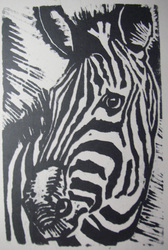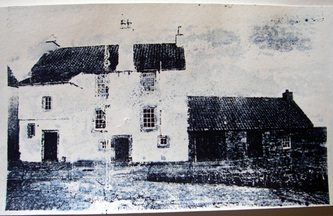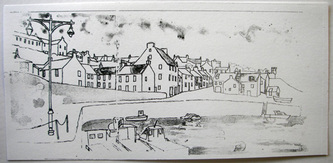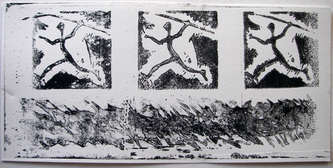I think it will take a while to process all the information of the last 4 weeks, covering screenprinting, collagraphs and etching, positives on PVC. I'm sure I've forgotten a lot already, but using their books as reference, I'm sure I'll be incorporating their methods into my work.
Our fourth and final week with Carol and Robert, concentrating on Etching using the Lascaux products they developed. We worked on copper plates using combinations of hard or soft resist, wash resist, stopout, aquatint and plate backing. All modern takes on traditional products and all safe, washable in water or Mystrol. The aquatint was sprayed on using an airbrush, all the other painted on the plate. Once the images were complete, the plates were put in the acid bath for around 30 minutes. My plate still needs more work, but I will proof print it on Tuesday to see what it needs. I think it will take a while to process all the information of the last 4 weeks, covering screenprinting, collagraphs and etching, positives on PVC. I'm sure I've forgotten a lot already, but using their books as reference, I'm sure I'll be incorporating their methods into my work.
0 Comments
For the final night we were revisiting the plates we had created on the course. I decided to concentrate on the Toray plate I created last week. The original image had been of a misty day on the promenade in Leven, Fife. I had used my Canon Pixma 610 to print it on to tracing paper, but the inks were not opaque enough. After several test exposures we settled on a short exposure of 4 light units. Those using a photocopier or laser printer needed an exposure of 9 light units. In developing the image I was trying a bit too hard to rub the image into life, but got one of those "happy acidents" where I rather liked the image - despite it bearing scant resemblance to the original.
I also printed a lithograph of my original zebra linocut. After the trouble printing the Omega plates I wanted a strong black and white image to try. It turned out fine, though I prefer the linocut by far. This Wednesday went a lot better using Toray plates, a silicon coated photosensitive piece of tin. The image has to be on acetate or tracing paper which is then exposed using a lightbox. A protective film is then removed and the plate developed and a purple dye wiped on to show the image clearly. You can feel the slight difference between the developed and undeveloped areas. After a quick rinse and dry the plates are ready to print, using Toray inks which are stiffer and more rubbery feeling than traditional Lithography inks.
The possible pitfalls in this technique are that inkjet prints are probably not going to be lightfast enough, so laser or photocopies again. Then a test strip is necessary to work out the optimum exposure for the image on the lightbox. The developer has to be applied gently with a lint free pad as it is very easy to remove the silicon surface and whatever marks you make will print. On a positive side, the plates are very thin and can be easily embossed with textures, so plenty of scope for experimentation, combining photographic images with drawings and textures. I've posted some of the images from last week. None were as I'd hoped, but they were attempts to see if I could reproduce watercolour effects. Obviously needs a lot of work and trial and error yet. Just back from Dundee and a frustrating evening. I do not know what was going on, but we all had great difficulty with our prints tonight. From too pale to too dark, roller marks, water marks, blocking up - just about everything that could go wrong did. So the mood was not quite as buoyant as last week, though we did eventually get a couple of decent prints by the end. Obviously, this process is going to take a lot to master it - maybe "instant lithography" was a somewhat misleading title for the course...
|







 RSS Feed
RSS Feed